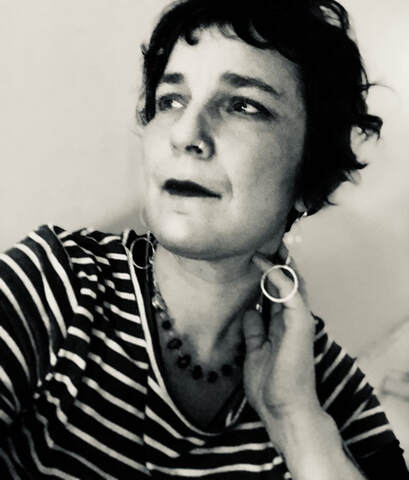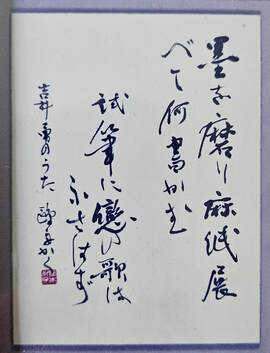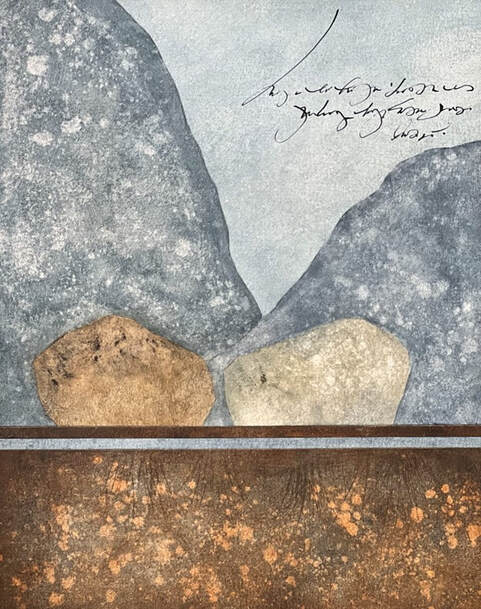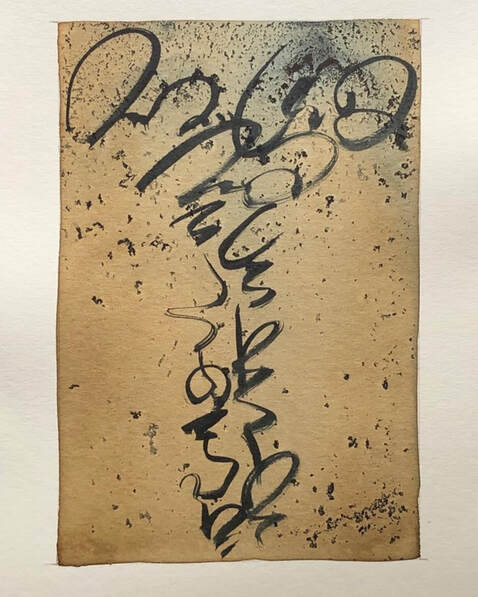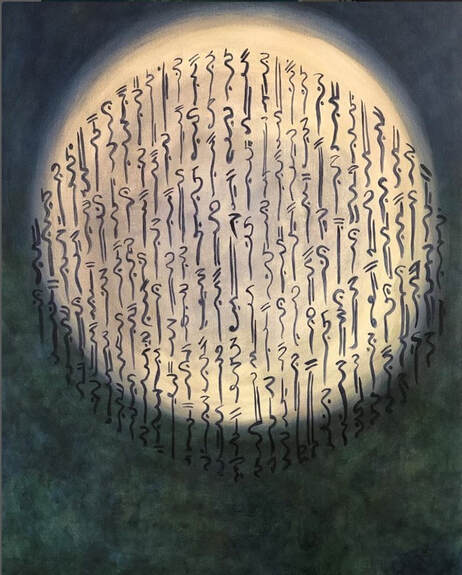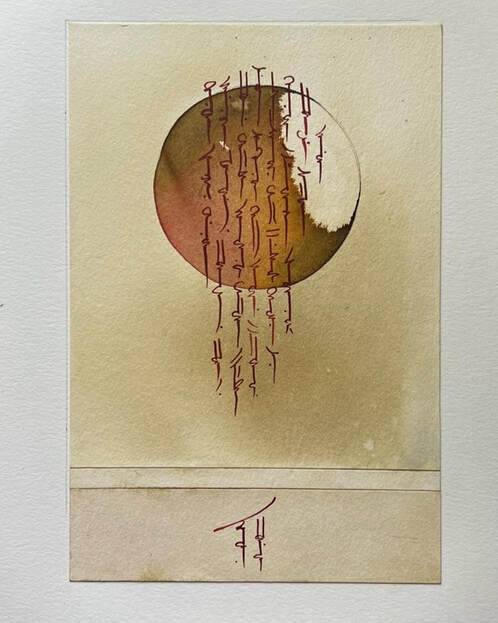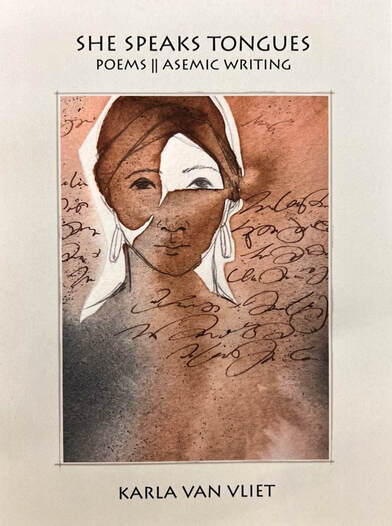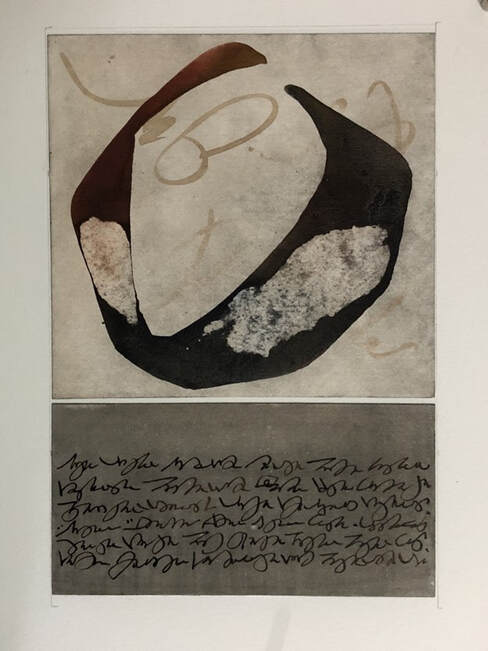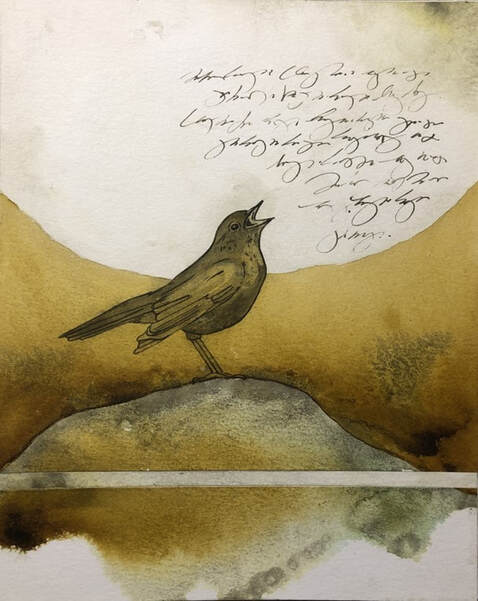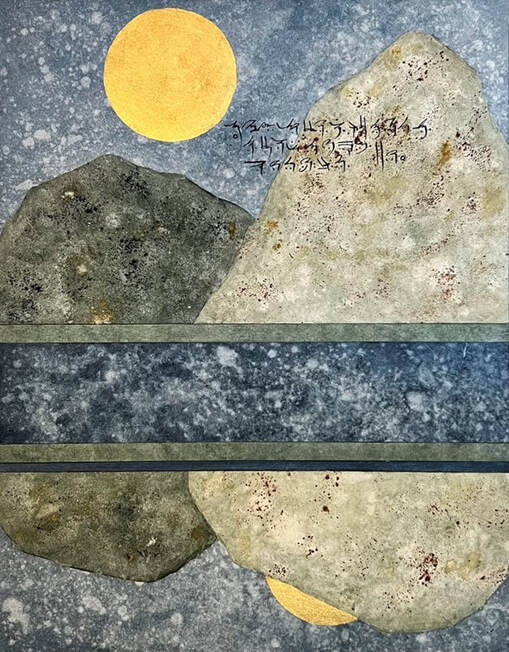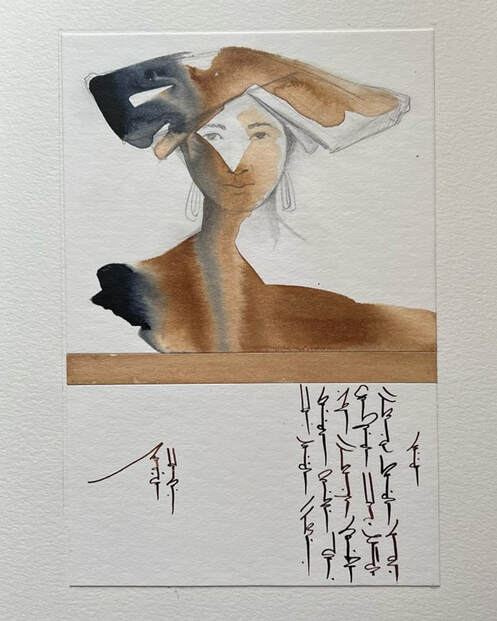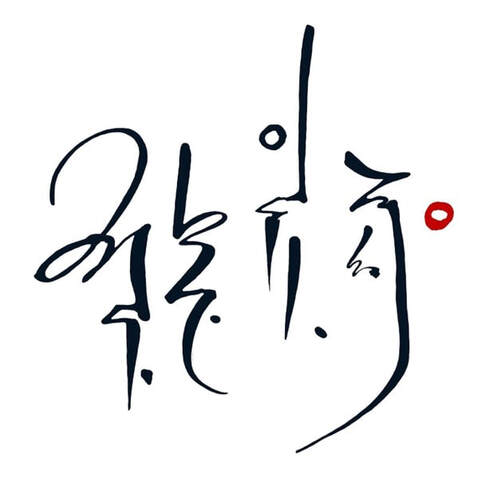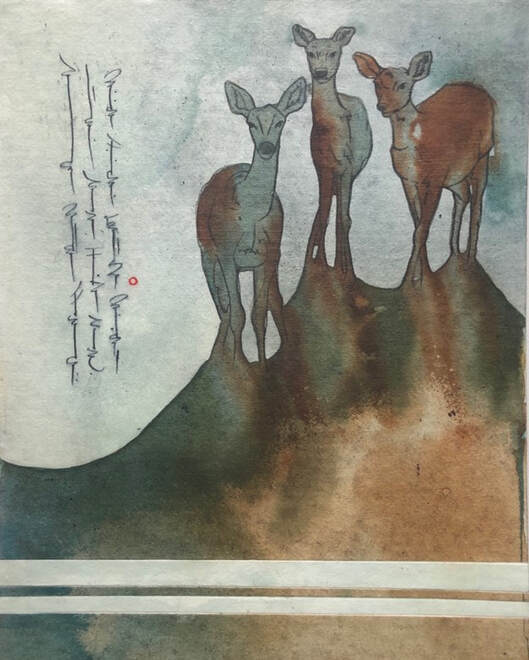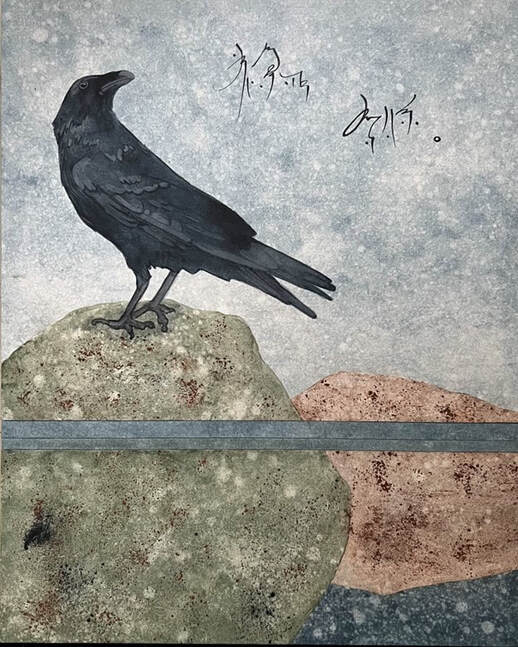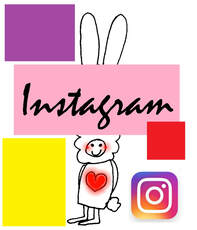|
You have no idea how much my mind is blown right now.
My belief was completely flipped, and I am thankful for my guest editor, Meg Reynolds, introducing me to asemic writing in her interview with Karla Van Vliet. So what exactly is 'asemic' writing? - Asymptote Journal Then, why is my mind blown?
My grandmother is a Japanese calligrapher who is ninety-six years old, and she still teaches. I was taught each stroke and each letter has a specific meaning when I calligraphed. I had practiced calligraphy every Saturday evening with my grandmother from the age of five until adulthood. I occasionally practiced in the early morning on Sunday - - crying, ideally joyfully - - when I learned the meaning of shapes, brush speeds, and letters' narratives. I had a perfect example for the proof. This is my grandmother's work. She wrote Isamu Yoshii's poem, "I should not write a love poem for my first draft" (summarized translation). In other words, you may not scribble until you decide on words with the specific feeling in your mind. When I scribbled, my grandmother said, "Your brush will be rumpled!" But, asemic writing is not just scribbling. Asemic writing is "a global style of writing", and it is an expressing of inner minds that is not easily described with words. And it is also activates the readers' sensory processing. It may be corny to ask, "Am I allowed to do that?" If so, the possibilities of my writing will be expanded. Karla Van Vliet’s newest books are She Speaks in Tongues (Anhinga Press,) a collection of poems and asemic writings, and Fluency: A Collection of Asemic Writings (Shanti Arts.) She is the winner of the Bacopa Literary Review’s Visual Poetry Award, a Finalist for the Tupelo Press Snowbound chapbook prize, a finalist for the Tenth Gate Prize, a Forward Prize, a three-time Pushcart Prize, and Best of the Net, nominee. Van Vliet’s paintings have been featured in Women Asemic Writers, UTSANGA.IT, Still Point Art Quarterly, Stone Voices Magazine, Champlain’s Lake Rediscovered, and Gate Posts with No Gate: The Leg Paint Project. She is a member of WAAVe Global (Women Asemic Artists & Visual Poets) and Asemic Writing: The New Post-Literate. Van Vliet is a co-founder and editor of deLuge Journal. She is the creator and curator of Van Vliet Gallery, and an Integrative Dreamwork analyst. Guest Editor, Interviewer: Meg Reynolds As a writing teacher, I have continuously worked with students of all ages to seek and find their written voice and transcribe it onto the page. Beyond the work of letters, phonemes, and punctuation, I have often asked myself, what lives beneath language? What lives inside the urge to write? My students sense the impulse, but often struggle, as many of us do, to translate the feeling of their ideas into written expression. Writing is an embodied act, but often their ideas crumble within the confines of writing conventions. They get lost in what they’ve been taught, feel inadequate, and lose the thread of what they wanted to say. Sometimes it is profoundly important to labor through these challenges to find their writing voices honed and shining on the other side. However, in the work of Karla Van Vliet, there is another path. Van Vliet’s asemic writing floods and leaps across the page, bending and blending mediums, so that the writing impulse closely aligns with its physical expression outside of the confines of writing itself. What happens when writing is unbound from writing? As you will see in Van Vliet’s work, work of extraordinary heart, fluidity and craft. Meg Reynolds: Tell me about your history with visual poetry. What led you to it? What does it mean to you? Karla Van Vliet:
My first entrance into visual poetry emerged from learning Chinese brush painting. I first worked in Chinese brush painting at a two hour workshop at the Lincoln Library in Lincoln, VT. Our instructor, Yinglei Zhang, was a practitioner and became an influence of mine in the practice. When I began painting, it was as though I had used the materials since I was born. Rice paper is unforgiving. Any mark that you make on the paper is permanent, even the earliest tentative marks. And even when these early marks are overlaid with firmer, darker ink, the first marks will be seen as ghost marks. You can learn to use these “mistakes” or “accidents” in your paintings as a technique. What is lovely, or what you might wish were different, is that the painting carries its history, much as we do in our bodies. Yet there is a brilliance in this, which is that they inform us and that they can lead to opportunities further down the line. They become part of your vocabulary. Traditionally brush paintings often include a poem. With the guidance of my brush painting teacher, I wrote poems in Chinese. Or as my teacher put it, paragraphs in Chinese (what I wrote followed none of the strict rules of Chinese poetry.) It felt like a way I could bring two parts of my creative expression together as I am also a poet. Ultimately I took the rules I was given and modified them.
Traditionally, I would have painted copies of existing images for years in a kind of apprenticeship before developing my own brush paintings, but my instructor said, “You’re American. You can do what you want.” So I used the techniques to begin painting Vermont landscapes and developed my own way of working with Chinese characters. Because I don’t know Chinese, to create writings meant searching for characters by meaning and visual impression. Once I had the characters, I integrated them into my paintings. At first in a more traditional way, and then more and more as larger components in the composition of the paintings. Several years ago, five in November, I dreamt of asemic writing flowing over a full moon; the image fell over and over all night. I was an observer in the dream, taking in frame after frame of written marks and the moon glowing behind them.
I had been introduced to the genre of asemics a few months before. Someone mentioned my work had an asemic feel to it. I didn’t know what asemics were so I did some investigating. I was interested but not until I had the dream did I start using it in my work. As an aside, I’m a dreamwork analyst; I take dreams seriously. So, when I had the dream, I knew there was something important in the practice for me. I started painting with inks and created many small book-page-like images. That spring I proposed to my publisher, Shanti Arts, a collection of asemic paintings accompanied by an essay on asemic writing which was published in January of 2021, as “Fluency.”
Later Kristine Snodgrass, of Anhinga Press, reached out to me wanting to publish my work. The book that came of that is “She Speaks Tongues,” a collection of poems and asemic writings. You work in asemic writing. Can you talk more about how your work explores and typifies the genre? Asemics is not thought of as the gesture of writing by all those who practice it, but because I come to it as a writer, a poet, I have thought of asemics as a way to keep my hand in the practice of writing. The brilliant poet Brigit Pegeen Kelly once said to me that we should honor the silences between times of writing. Instead of beating ourselves up about not writing, “am I a poet if I haven’t written a poem in so long?!” that we should think of those times as a part of the practice of writing, a gathering time.
When asemics entered my life, I was in one of those quiet times. I found a kind of grounding in the gesture of writing, a gathering, without the need for words or even an understanding of my written expression, or even what I wanted to express. It was after the fall of 2016 when election results laid bare the difficult realities and history of our country and I thought of my continued expression as defiance against that which the elected administration stood for. My work is more closely linked to writing “form” than other asemic artists. That is, I usually “write” from left to right or from top down. Others are not as tied to this convention. What I am seeing now, in my current work, is the placement of my asemics within a painting, much like the Chinese poem is used, to balance a painting. Someone, I believe Michael Jacobson, one of the fathers of modern asemics, has amended the definition of asemic writing on Wikipedia with “a hybrid art form that fuses text and image into a unity, and then sets it free to arbitrary subjective interpretations. It may be compared to free writing or writing for its own sake, instead of writing to produce verbal context.” I like this very much. But still there is the question of meaning.
People often ask me what the writing says. I say, whatever it says to you… and that can change. If I were going to rename the movement, I would call it parasemic, meaning “side by side”. Of course, a mark can’t have no meaning. A line in the sand has plenty of meaning. The meaning is intuited or perceived, each with their own understanding.
Where do you begin with your pieces? What materials do you use and explore and in what ways does your creative voice (color choice, composition, etc) guide you in building the work? With my newer pieces, to begin, I take a piece of watercolor paper and I draw out where different components will be. I get out my paper cutter and I cut horizon lines. Using acrylic matte medium, I mix in my pigment(s), and then I paint into spaces. I use a variety of techniques to add texture and color, spritz it with water and/or sprinkle in other pigments. In order to create the finished image, I have an exacting collage process where I layer my treated pieces of paper onto a board.
In both my artwork and poetry, I have a process of stilling myself to listen to the symbols and colors of my work (stone, water, birds, and so on), and intuitively decide how each element corresponds to itself to balance into the space of the artwork. I have a few pigments that are my favorites. Also, the horizon line has an important presence in my artwork. In my early years I lived in Lincoln, VT. I would walk out behind our house on South Mountain to a place at the top of the cliffs looking west. You could see an amazing view of the Adirondacks, a horizon of layered mountains. That image has stayed with me. It is one of my earliest memories, and the image touched me deeply. Likely it was the beginning of seeing and collecting images from the landscape around me that I would later mine for my poetry and my artwork. What relationship does asemic writing have to contemplation? Do you have contemplative practice and if so, how does it feed your work? I grew up as a Quaker, sitting in silence. As a child I learned this quiet space was where one connected with the light (divine) within. Also, as a child I couldn’t sit quietly for an hour and my sister and I were allowed to leave the building and walk down the dirt road to the creak and back as the service continued. I remember the quality of the light, the bird calls, the shadows thrown by stones in the gravel road. This noticing became associated with that space of contemplation. And again, I collected these images.
I often thought of myself born a bird, in this world but not really of it in some way. For years I had a spiritual practice connected to this way of being. I was described as ethereal. Strange to me but also understandable. But more recently I have felt a shift. I feel that this part of my life is centered around learning to be in my body in the world, on the earth. I think it is the opposite of many, to find the earth later in life rather than finding a “spiritual” practice later in life. The way I think of it is that living on the earth is a spiritual practice. In the language of Jesus, Aramaic, heaven and earth can be in the same place, are in the same place. My contemplative practice is about becoming as close to myself as possible and to live from that self as much as I can. This doesn’t always look meditative, because becoming close to myself involves all of me, all of my feelings, not just the pleasant ones. My paintings and poetry are containers for this way of being.
How that shows itself in my creative work is that I listen for that inner voice and how it wants to communicate, express in the world, and then I do that. It’s very intuitive. Following the small voice within even when it doesn’t make sense in my mind. Why would I cut the painting there? Use that color? But I do it anyway. Also, painting, writing, asemic writing, are all places, I sometimes think, where I work to create order, or stillness, or a calmness. As one who carries trauma it is one of the ways I process those traumas in myself. I think this is the quality that people see in my work and call Buddhist. Who inspires you as you work? Who are some of your earliest visual and poetic influences? Adrian Rich, Audre Lorde, and Mary Oliver were my first poetic influences. Mary Oliver resonated with my connection to nature imagery and Adrienne Rich and Audre Lorde for their bravery in speaking their truth, which I needed to do for myself. They gave me a blueprint for doing that. Also, Denise Levertov, Isak Dinesen, early W.S. Merwin. Visually, the landscape of Vermont where I grew up, and such disparate artists as Rothko, Charles Mackintosh and Frida Kahlo. And of course, so many others in so many ways.
At the moment I am reading the brilliant book What My Bones Know by Stephanie Foo, a nonfiction book about her experience and investigation of Complex PTSD. I’m also reading Kate Partridge’s new book THINE, which is lovely, and The Maybe-Bird by Jennifer Elise Foerster which I find very inspiring. Other recent loves: Meg Kearney’s “All Morning the Crows,” Melissa Kwasny’s work, Tom Pickard’s “Fiends Fell,” and Jerry Saltz’s “Art is Life.” What are you currently working on? My current work is inspired by the river, an inspiration I come back to time and again. There is this lovely little book I discovered via Robert MacFarlane, who wrote the foreword, called “The Water Glossary” by Carol Anne Connolly. It’s a collection of Irish words for or about water. The definitions are fantastic (“gall-shion – severe weather, as if it blew from a strange country”) and it inspired me to create a series of paintings. They are abstracted sky | rock | water | asemics, and recently I’ve added birds, mostly crows/ravens to the pieces.
I am working on paper using acrylic medium and pigments, many of the pigments created from my own flowers. I mount the pieces to a cradle board and seal them so they can be hung as is and not have to be put under glass. Thinking back to the first question; these paintings have a relationship to those early brush paintings with “poem.” Each one also incorporates asemic writing into them, much like a traditional brush painting. Interesting. Hmmmm. Working On Gallery Past Guest Editors: Meg Reynolds Francesca Preston Lúcia Leão Support Working on GalleryYour $25 donation will be a tremendous support for Working on Gallery's future guests and running costs. If you become a patron, your name will appear in the next Working on Gallery's article. In addition, you will receive my first poetry book, "Where I Was Born", for U.S. shipments. Or, you will receive a thank-you letter for international shipments. Working on Gallery has been used by universities, advanced-level art lectures, and writing workshops. Your donation will help this gallery be more successful. Thank you so much - Naoko Fujimoto Comments are closed.
|
Archives
July 2024
|
フジハブ
Welcome to FUJI HUB: Waystation to Poetry, Art, & Translation. This is not your final destination. There are many links to other websites here, so please explore them!
Welcome to FUJI HUB: Waystation to Poetry, Art, & Translation. This is not your final destination. There are many links to other websites here, so please explore them!
What are you looking for?
FUJI HUB Directory
Popular Sites:
Gallery of Graphic Poems
Working On Gallery
(Monthly New Article by Writers & Artists)
About Naoko Fujimoto
Contact
Naoko Fujimoto Copyright © 2024
FUJI HUB Directory
Popular Sites:
Gallery of Graphic Poems
Working On Gallery
(Monthly New Article by Writers & Artists)
About Naoko Fujimoto
Contact
Naoko Fujimoto Copyright © 2024
